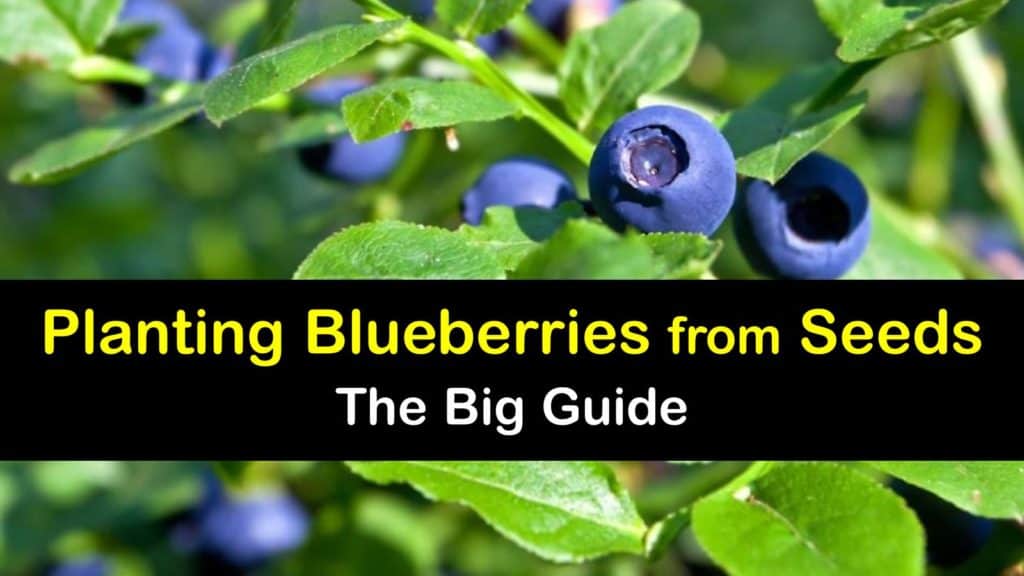Blueberries are undeniably delicious, and these tiny pops of juicy fruit should most definitely make an appearance in your home garden this summer. Learning how to grow blueberries from seed is a rewarding process because you get to appreciate the simplistic nature of the bush during the early spring and then feast on its bounty in the summer.
The fruits may be wonderful, but the bush itself stands on its own and is a beautiful plant to have on your property. Growing blueberries from seed isn’t too challenging, either, meaning that your first attempt at growing fruit won’t be overwhelming.
When you learn how to plant blueberry seeds, you’re getting more than gardening knowledge. You’re also adding to your curb appeal and bringing in fresh, nutritious ingredients to your kitchen.

Things to Know Before Growing Blueberries from Seed
What are blueberries? These small fruits are tasty and well worth adding to your garden. There is not a lot of difference between huckleberry vs blueberry when growing them.
Blueberry bushes have bright green foliage throughout the growing season and then turn purple, red, orange, and yellow during the fall.
If you’re ready to start planting blueberries from seed, let’s dive right in and start understanding everything that goes into the process.
There are two routes to take when planting blueberry seeds. In other words, there are two different types of blueberry plants. The first type is called Vaccinium corymbosum, or highbush blueberries.
The second is Vaccinium angustifolium or lowbush blueberries. Highbush varieties are the most popular ones and are most likely the kind you find at your grocery store. Of course, there are some hybrid varieties to mix the two.
Highbush blueberry plants are deciduous and woody shrubs. This type grows up to eight feet tall when fully mature.
As you probably already guessed, lowbush berries are much shorter but are still deciduous woody shrubs. These are more likely to be wild blueberries that usually only reach two feet high.

Another critical difference between these two blueberry bush types is that highbush plants grow in warmer climates, and lowbush grow in cooler temperatures. Highbush is hardy in USDA zones four through eight, while lowbush is hardy in zones two through seven.
All blueberry plants must go through cold stratification, where they have between 150 to 1,000 chilling hours. This number depends on the cultivars you’re growing.
Chill hours only take place when temperatures remain between 32 and 45 degrees Fahrenheit in the winter. This process is necessary for the plants to produce flowers and fruits the following growing season.
Now that you know the biggest differences between these two blueberry plants, you’re on your way to figuring out how to grow blueberries from seed.
How to Plant Blueberry Seeds
The only way to learn how to plant blueberry seeds is to start by propagating them from bare roots, cuttings, transplants, or from starting seeds. Regardless of the method, prep your soil well before you stick anything in the ground.
If you have heavy sandy or clay soils, work in some composted organic matter like pine needles or sawdust to create the perfect conditions for the berries to grow.
Propagation from Seed
Propagating berries from the seed is the most challenging of all your options, similar to growing strawberries from seed in containers. It takes longer to produce fruit, and you can’t harvest them the first year. Purchase blueberry seeds from a local nursery or extract them from berries you already have at home.
To remove seeds from berries, place a cup of blueberries in a blender with four cups of water and turn it on for 15 seconds. Let the blended mixture sit for another ten minutes to make the pulp rise to the top.
Carefully pour out the pulp, and let the mix sit for another five minutes. Repeat this process until the water is clear and you have only blueberry seeds on the bottom. You can do the same thing when planting blackberries from seed to remove the seed from the fruit.
A few months before your area’s last frost date, sprinkle the seeds over some sphagnum peat moss, decaying plant matter that helps nourish your seeds.
Place a thin layer of the peat over the top and cover them with a damp paper towel or plastic dome to keep the moss moist. Store the seeds between 60°F and 70°F to help with germination, which could take two to three months.
Like when planting raspberry seeds, when the seedlings are three inches tall, remove them from the peat moss and put each one in a six-inch pot full of equal parts peat, sand, and regular potting soil. Set the containers in a sunny location that gets six hours of direct light.
Knowing when to plant blueberry seed is also important. When the danger of frost is out of the way, it is safe to plant the seedlings outside. Don’t forget to harden off seedlings by putting them outside for increased periods every day for one week.
How to Grow Blueberries from Seed
Growing blueberries and watching them bear fruit is incredibly satisfying. Blueberry plants are ericaceous, meaning they love acidic soil like azaleas and rhododendron.
According to Cornell Cooperative Extension, plant blueberries in a location with full sun and a soil pH level between 4.0 and 6.0. If your soil pH is too high, try growing them in raised beds or containers.
Blueberry plants also enjoy loam soil, and mixing in finely chopped bark mulch or pine sawdust is an intelligent way to improve aeration.
Try not to place them where they compete with other plants because their shallow root system doesn’t dig deep for food and water. Plant a pretty cover crop to improve the soil and deter weeds from growing.
Most blueberry plants are self-fertilizing, but cross-pollination encourages a bigger harvest. This is also helpful because honeybees, bumblebees, and native bees are the only insects that pollinate blueberries.
Blueberry bushes enjoy moisture. Wild types are usually found in swampy or boggy areas. Their shallow roots mean they dry out quickly.
Give blueberries two inches of water every week. If you don’t get a lot of rain, add a drip irrigation system to the garden. Mulching around the base of the blueberry plants also helps retain moisture.
If you use liquid fertilizer, make sure the plants are in the ground for at least six months first. Use fertilizer specifically designed for acid-loving plants. In the second year, fertilize them when new growth emerges and then again every six weeks.
Pruning Blueberry Bushes
Get used to your garden tools because it is necessary to prune your blueberry plants. Growing blueberries from seed is only a slow process at first; once they take root, they are fast growers.
Old canes produce smaller fruits, so encourage the new ones to keep growing. Pruning mainly happens after the first two years of life.
In the third year, remove canes that become twisted or cross. Plants emerge from dormancy at the end of March. Get all your pruning done before this happens.
Try to remove canes that didn’t produce a lot of fruit during the previous growing season. Only use clean clippers when working with your plants to prevent the spread of pests and diseases.
Managing Blueberry Pests
The most significant pests you face when learning how to plant blueberry seeds are birds. Birds love these fruits as much as we do, and it is challenging to beat them to it.
The best method to force them away is to string netting over your plants once the first berries start to turn from green to shades of blue. You can also try making a bird deterrent with grape Kool-Aid, which contains methyl anthranilate.
Mix four packs of grape Kool-Aid with one gallon of water in a large bucket. Mix everything thoroughly, and dump it into a garden sprayer.
Spray the blueberry plants whenever your berries start to turn blue and reapply the solution once every few weeks. If the spray attracts ants, sprinkle a thin layer of diatomaceous earth around the base of your blueberry shrubs.
Harvesting Blueberries
Harvesting is the most exciting time of the blueberry-growing process. This is when all your patience pays off, and you finally get to enjoy the fruits of your labor.
Blueberries don’t reach their peak production until about seven years old. The best time to harvest blueberries starts after their second year. Allow the blueberries to fully ripen before harvesting because they won’t ripen after you pull them from the plant.
Look for berries with matte blue stems. They should detach easily with one pull. If the berries grow in a cluster, avoid picking them all and pluck one at a time.
To store the berries, put them in the refrigerator immediately to extend their shelf life. Do not wash freshly picked blueberries until you are ready to eat them.
The best way to freeze fresh blueberries is to spread them on a cookie sheet and set them in the freezer for a few hours. When frozen, transfer them to an airtight container.
Blueberries are a summer food staple, and we don’t realize how beneficial they can be in our own backyards. Even if you have to fight the birds for them, learning how to plant blueberry seeds is something that you’ll never forget.

If learning how to grow blueberries from seed has added color to your yard and nutrition to your kitchen, share these tips for growing blueberries from seed on Facebook and Pinterest.